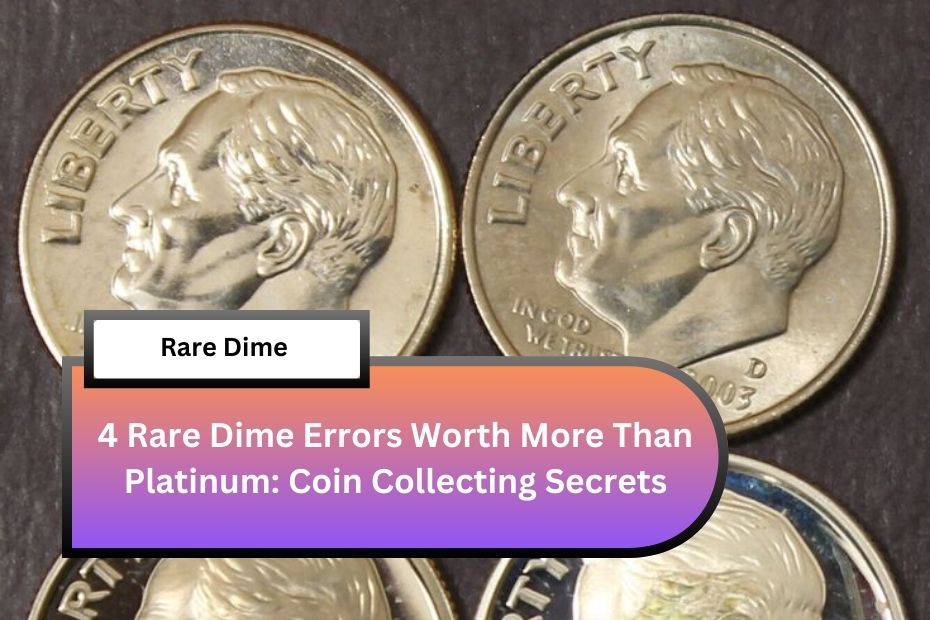Coin collecting is an exciting hobby for many people, and one of the most thrilling parts is discovering rare and valuable coins. Among the many types of coins, dimes hold a special place, especially when they have unique errors. These errors, which occur during the minting process, can make the coin far more valuable than its face value. In some cases, these rare dimes are worth even more than platinum! In this article, we will explore four rare dime errors that coin collectors highly prize for their significant worth. Whether you’re a coin enthusiast or just curious, these errors show how a small mistake can lead to a big reward.
1. The 1975 Double Die Obverse Dime
The 1975 Double Die Obverse (DDO) is one of the most famous and sought-after dime errors. This occurs when the die (the tool used to strike the design onto the coin) shifts slightly during the minting process. This results in the design being stamped twice, leading to a clear doubling of certain features, especially on the inscriptions like “Liberty” and “In God We Trust.” The doubling effect makes the coin easy to spot and highly valuable.
Because only a few examples of the 1975 DDO dime exist, it’s a rare find in the world of coin collecting. Depending on the condition of the coin, a 1975 Double Die Obverse Dime can be worth anywhere between $1,000 and $15,000. This dramatic value increase comes from the rarity of the error and the high demand among collectors.
2. The 1982 “No Mintmark” Dime
Mintmarks on coins are small letters that show where the coin was made. Normally, dimes have a mintmark that indicates which U.S. Mint facility produced them. However, in 1982, some dimes were accidentally struck without a mintmark, even though they were produced at the Philadelphia Mint. This mistake is very rare and makes the 1982 “No Mintmark” dime a highly sought-after coin.
Because of the rarity of this error, especially since the Mint usually catches such mistakes, the 1982 “No Mintmark” dimes are worth much more than regular dimes. Depending on its condition, this error dime can fetch up to $1,000 or even more at auctions. Collectors love finding these unique coins, and the value only continues to rise as fewer are discovered each year.
3. The 1964-D Dime with a “D” Mintmark Overstrike
The 1964-D dime is another rare and valuable error coin, but what makes this one special is the “D” mintmark overstrike. This error happens when a 1964 dime is accidentally struck with a mintmark from an earlier year, leading to the overstriking of the “D” mintmark. This results in a double-error coin: one for the incorrect mintmark and the other for the overstrike itself.
Because the 1964-D dime with a “D” mintmark overstrike is so rare, it commands a high price on the collector’s market. Coins in good condition can be worth upwards of $5,000, making this a highly valuable find for anyone lucky enough to come across it. The historical importance of this coin adds even more to its appeal.
4. The 1996 Off-Center Dime
Off-center strikes are one of the most common types of minting errors. This happens when a coin is not perfectly aligned when it’s struck by the die, resulting in part of the design being cut off. In the case of the 1996 off-center dime, the error is so extreme that the coin looks almost like a fragment of a regular dime, with a large part of the design missing.
The 1996 off-center dimes are especially rare because the misalignment is so extreme that the coins look very unusual. These coins can fetch prices of up to $2,000 or more, depending on their condition. The more extreme the off-center strike, the higher the value. For collectors, these off-center dimes are considered a true gem in the world of error coins.
Why Dime Errors Are Worth So Much
Dime errors like the ones mentioned above are valuable because of their rarity and uniqueness. While most coins are struck with perfect designs, errors occur when something goes wrong during the minting process. These mistakes make the coin different from all others, and in the world of coin collecting, this difference can add significant value.
For collectors, finding a rare dime error is like finding treasure. These coins are hard to come by, and their value only increases as time goes on. Whether you are just starting to collect coins or have been doing so for years, it’s worth taking a close look at your collection to see if any of these rare and valuable dime errors are hiding in plain sight.
Conclusion
Dime errors are more than just mistakes made during the minting process; they are highly prized treasures in the world of coin collecting. The 1975 Double Die Obverse, 1982 “No Mintmark,” 1964-D “D” Mintmark Overstrike, and the 1996 Off-Center Dime are just a few examples of coins that can be worth far more than their face value. In fact, some of these rare dime errors can even exceed the value of platinum, one of the world’s most precious metals. For anyone interested in coin collecting, finding one of these valuable errors can be an exciting and profitable experience.
FAQs
1. What makes a dime error valuable?
Dime errors are valuable because they are rare, and collectors pay a premium for unique mistakes in the minting process.
2. How can I identify a rare dime error?
Look for noticeable features like doubled lettering, missing mintmarks, or off-center strikes that make the coin different from standard dimes.
3. Can any dime from circulation be worth more than platinum?
While most dimes aren’t worth much, certain rare errors, like the 1975 Double Die or 1982 “No Mintmark” dime, can be worth thousands.

